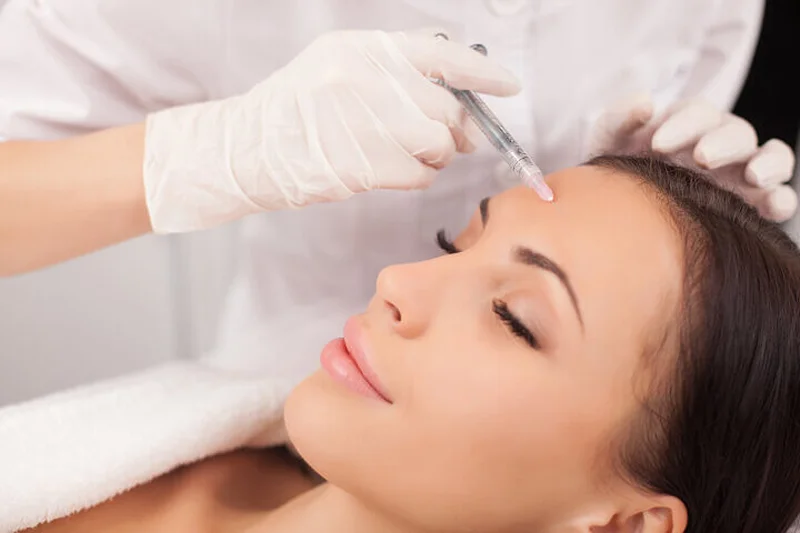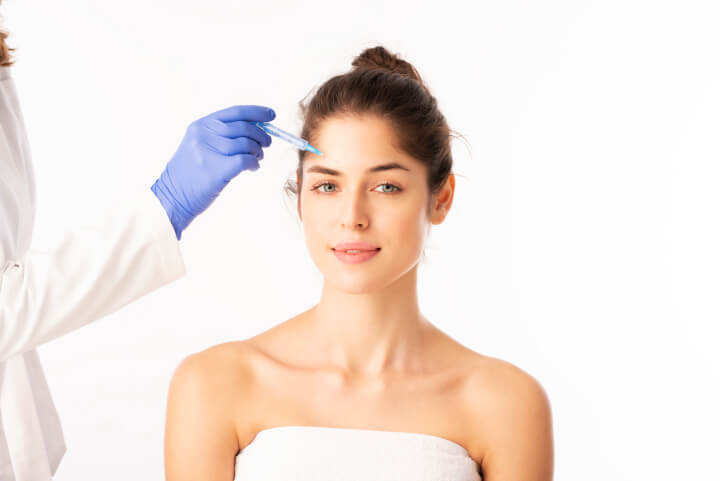The Long-Term Effects of Botox Injections on the Forehead

Botox injection is known for reducing deep wrinkles and forehead lines. It also cures conditions like cervical dystonia, excessive sweating, an overactive bladder, and a droopy eyelid; a chronic migraine and tension headache may be prevented by Botox treatment. Botox uses a toxin known as botulinum toxin type A to temporarily paralyze a muscle. The microbe that triggers botulism, a type of food poisoning, produces this toxin.
So what are the long term effects of Botox on forehead? When a patient gets excessive Botox for the forehead wrinkles, it may result in muscle weakness, in addition to looser and thinner skin. Furthermore, as the muscles deteriorate, they may begin to attract surrounding muscles when doing facial expressions. If a patient ceases using their facial muscles, they may start squinting with their nose and develop bunny lines.
With just a few simple injections, our providers can erase your wrinkles and fine lines in no time with Botox. Call us today to book your appointment.
Understanding How Botox Affects Skin in the Long Term
Botulinum toxin injection works by blocking specific chemical signals from nerves, most of which cause muscle contraction. It’s commonly used to momentarily relax the facial muscles that cause dynamic wrinkles and frown lines. Botox injection also treats conditions that malfunction the body.
We all make extensive use of our facial muscles. All of that speaking, emoting, eating, and general daily activities give the facial muscles a great workout throughout the day. It’s beneficial for the health of those muscles, but it can cause skin issues.
For instance, when scrunching your face up when unhappy or concentrated, a person may develop frown lines, which are the small lines that appear between the brows. A specialist or aesthetician must be ready to explain how Botox works on the skin to patients without experience with Botox. It’s necessary to understand the most common areas for injections.
They include forehead lines, crow’s feet around the nose, and frown lines. Among the most frequently requested procedures is the removal of forehead wrinkles. These lines are typically genetic, and they can be seen in both children and adults. However, Botox isn’t advisable for anyone below 18 years old.
They can also be seen in people with exaggerated facial expressions. It’s critical for the patient to know what they desire. Some people prefer to have no wrinkles on their forehead, while others prefer to have wrinkles but not deep ones. These outcomes are achievable by varying the amount of Botulinum toxin injected into the muscles.
aNu Aesthetics has done an excellent job of educating their patients about the frown lines between the eyebrows. Once more, these can be hereditary or caused by overly expressive people’s facial expressions. Not everyone has frown lines. But, most people don’t want to appear angry, so if they do, they’ll probably want them to disappear.
It’s a simple at-home procedure that can be completed quickly and looks good! Crow’s feet (also known as smile lines) are small lines that appear around the eyes due to skin wrinkling to support smiling and squinting. They’re the third most common area of the face. Men may be fine with crow’s feet, but women generally prefer to get rid of them.
It’s a quick procedure that usually takes 3 to 10 days to remove a facial wrinkle. It’s also critical for patients to understand that cosmetic injectables can only treat facial lines due to muscle activities. Understand that sun-damaged lines and creases won’t react to these treatments.
Furthermore, some patients believe that Botox can treat deep wrinkles around their nose (nasal labial fold) and mouths (marionette lines). Sadly, they can’t. A dermal filler such as Juvederm/Voluma, Restylane, or hyaluronic acid might be necessary.
Botox injections, like all other cosmetic procedures, have side effects despite being FDA-approved. Botox injection’s immediate adverse effects may include flu-like symptoms, nausea, and headache.
There could be facial pain and muscle weakness, causing double vision and drooping eyelids. These side effects will go away with regular treatment. These side effects may not be visible right away, but they’re long-term and possibly dangerous.
Learn More: Side Effects of Botox on Forehead
Why Does the Skin Appear Older After Botox?
When some people notice that their wrinkles have returned after a Botox treatment, they assume that the treatment has exacerbated their wrinkles. It’s completely false. Consistent Botox use can retrain specific muscles to move less, resulting in smoother skin with little Botox over time.
Botox injections typically start working one to three days after being administered. The effect can last for three months or longer, based on the treated issue. A patient may need to get follow-up injections regularly to maintain the results.
The face comes back to its natural condition after Botox wears off. The dynamic wrinkles that the Botox had hidden reappeared. Botox won’t result in any new wrinkles. To better understand why Botox can’t cause wrinkle development, consider what triggers dynamic wrinkles and what Botox does.
The best approach to prolong the effect of Botox is to work with the doctor on a maintenance treatment regimen. Schedule the appointments before the results fade. Regular Botox treatments are highly beneficial because they direct muscles to react to the neurotoxin for lengthy periods.
A good example is the glabellar lines between the brows. Patience and faith in the doctor are essential. Don’t go overboard. Excessive treatments in a short amount of time can cause the muscles to resist Botox or to react negatively.
Learn More: Botox Forehead Treatment: What to Expect?
Avoiding Botox Resistance
Botox resistance occurs when a patient either develops antibodies against botulinum toxin or metabolizes the Botox drug instantly. As a result, Botox injections deliver poor results, a brief effect, or no impact at all. Using a pure botulinum toxin product is a way to minimize resistance. But since botulinum toxin is created by microbes, it must be purified before use.
Various brands purify Botox in distinct manners. If superfluous proteins remain in the product, they can act as adjuvants in a vaccine, stimulating the immune system to respond more strongly. It increases the likelihood of resistance.
The frequency with which Botox treatments are performed also makes a big difference. Experts believe that waiting more than three months between procedures is beneficial. The quantity of Botox used also has an impact on the results. Utilizing as little Botox as possible reduces the likelihood of resistance.
If resistance does evolve, it can vanish — but this is a slow process. Research has shown that after patients become resistant, this can take 4 to 5 years for the antibodies associated with resistance to drop.
A 4 to 5-year pause from botulinum toxin treatment is necessary, which may be problematic if the toxin is being used to treat medical problems. Patients who are developing resistance can still be adaptable to toxins with reduced immunogenicity. It’s to ask if the toxin used by the injector is the best option for decreasing the probability of procuring resistance.
Long-Term Health Effects of Botox
Botox cosmetic procedure is generally safe when administered by a skilled health care professional. The following are some of the potential long-term adverse events and complications:
- Excessive tearing or eye dryness
- Drooping eyelids or brow ptosis
- Drooling or a crooked smile
- Flu-like symptoms or a headache disorder
- Injection site pain, swelling, or bruising
Although highly unlikely, the toxin in the injection could spread throughout the system and can rarely trigger iatrogenic botulism.
They inhibit neuromuscular propagation, making iatrogenic botulism and myasthenia gravis clinically similar. Once a person observes any of the following side effects within hours to weeks of receiving Botox, contact the doctor immediately:
- Bladder control issues
- Breathing difficulties
- Speech or swallowing difficulties
- Issues with vision
- Muscle weakness
For pregnant or breastfeeding women, medical professionals advise against doing a Botox procedure. Furthermore, Botox shouldn’t be utilized in people with an allergic reaction to the protein found in cow’s milk.
Know More About Our World-Class Skin Rejuvenation at aNu Aesthetics™

Botox should only be used under the supervision of a medical professional. In terms of preventing side effects, injections must be precisely placed. At aNu Aesthetics, we can guarantee that the preventative Botox and other services we offer are done correctly. We have many years of expertise and specialization in your condition and have prior experience with the Botox effect. Because of that, we performed many successful treatments on people struggling with facial lines such as fine lines, glabellar lines, and other types of wrinkles.
Our highly trained and fully accredited practitioners can advise you on the procedure and help you decide on what’s best for your needs and health. aNu Aesthetics and Optimal Wellness offers the science and art of rejuvenation, relaxation, and skincare. Experience our world-class services by reaching us today to get a free consultation or to schedule your next appointment.
With just a few simple injections, our providers can erase your wrinkles and fine lines in no time with Botox. Call us today to book your appointment.